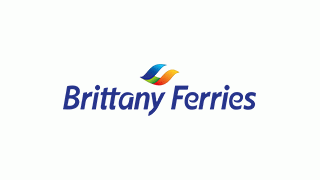- Members
BRITTANY FERRIES | Inaugurates its first liquified natural gas ship in the port of Bilbao

Last March 29th, the "Salamanca" arrived at the port of Bilbao after its maiden voyage from the United Kingdom.
This new ship will connect Bilbao with Portsmouth twice a week (return voyage) and will also cover a weekly return voyage from Portsmouth to Cherbourg (France).
The inauguration ceremony was attended by authorities and members of the port community, who were addressed by Christophe Mathieu, the CEO of Brittany Ferries and Ricardo Barkala, President of the Port Authority of Bilbao.
The guests at the inauguration were offered a guided tour of this new ship.
A LUXURY DESIGN
The inside of the "Salamanca" is inspired by the city of the same name. The city is always present, from the works of art to the food offered onboard.
Style, comfort and attention to detail can be seen and experienced in all parts of the "Salamanca".
A tour of its decks takes the passengers on a journey related to the city that inspired its name. On deck ten there is an enormous exterior terrace and three game rooms for children to rest and have fun.
Numerous rooms, restaurants, bars and two large shops located in the heart of the ship complement the leisure activities.
The "Salamanca" is one of the largest ships in Brittany Ferries' fleet, prepared to transport passengers, cars and goods on trucks with or without trailers, covering the Bilbao - Portsmouth route, in about 28 hours.
TECHNICAL DATA
Length: 215.50 m.
Beam (width): 27.8 m.
Draft: 6.60m.
Tonnage: 41.716 UMS
Decks: 10
Passenger decks: 3
Speed: 23 knots
Passengers: 1,015
Crew: 85
Cabins: 1,015
Pet-friendly cabins: 22
Vehicle capacity: 2.7 Km. in a line
Engines: 2
LNG capacity: 783 Continued inside…
MARCH 29TH ... 2011
On the Bilbao-Portsmouth route, the "Salamanca" replaces the "Cap Finisterre" ship, whose first stopover in the port of Bilbao took place on March 29th, 2011. Since then, over 953,000 passengers and thousands of trailers have used this service as a bridge between Bilbao and the United Kingdom.
"SALAMANCA": AN ECOLOGICAL SHIP
The "Salamanca" was built in the Weihai shipyard in China and designed in Europe by the Swedish architect Richard Nilsson and the German top-range cruise liner interior specialist Rheinhold & Mahla. The Greek company Aluminox Marine supplied the galley and bar equipment, and the installation of artworks, accessories and specific finishes was done in Spain by the firm from Vizcaya, Oliver Design.
The "Salamanca" will be the first LNG ship to sail the English Channel. According to the shipping company, thanks to this fuel, air pollutants such as particles, sulphur dioxide and nitrogen oxides will be almost entirely eliminated. Carbon dioxide emissions are also reduced by up to 20%, and combustion is more efficient.
LNG is not the only thing that makes the "Salamanca" a more ecological ship. The long and slender design of its hull contributes to a high level of hydrodynamic performance. The silicone paint applied to the hull reduces friction by its smoothness travelling through the water, thus also reducing fuel consumption.
The "Salamanca" has finned anti-roll stabilisers that have proven their efficacy in the Bay of Biscay.
Moreover, the hydrodynamic efficacy of this type of ship and its excellent behaviour on the sea allow it to be fitted with only two engines instead of the four that these types of vessels normally have, resulting in considerable energy savings. Each Wärtsilä 12V46DF engine has a power of 13,740 kW, and the variable speed alternators provide the means to recuperate energy even at low speeds, saving fuel and reducing CO2 emissions.
As LNG engines produce almost no sulphur dioxide emissions, the "Salamanca" does not need a scrubber, which means less electricity consumption.
Thanks to robust real-time onboard data analysis and the development of automatic learning, energy efficiency can be optimised at any time. The vessel has a new navigation tool called "smart docking system" to facilitate docking manoeuvres, designed to help captains in the approximation to the dock, and thus also reduce the time needed for manoeuvring.
GREAT BRITAIN AND IRELAND FROM BILBAO
After opening the port of Bilbao - Portsmouth route in 2011, which admits all kinds of goods, including temperature-controlled and extra-large cargo, now reinforced with the "Salamanca", on March 19th , 2013, Brittany Ferries has added the Bilbao – Poole line, for trailers, either accompanied or alone, project load, IMDG and controlled temperature cargo.
The ship "Cotentin" launched the service, followed by the "Pelican", which continues with the service between both ports twice a week.
Departing from Bilbao on Tuesdays and Saturdays, it reaches the English port after a 48-hour voyage.
On February 28th, 2020, the ship "Kerry" joined these two services on the Bilbao - Rosslare (Ireland) route, later replaced by the "Connemara", which Brittany Ferries has recently announced that it will be replaced by the "Galicia", a larger capacity ship, and which, like its predecessors, is of the Ro-Pax (Roll-on/roll-off passengers and goods) type.
Departing from Bilbao on Wednesdays and Fridays, it connects trade in the Iberian peninsula with Ireland in just 26 hours, enabling, for example, to reach the Dublin market on Monday after sailing during the weekend.
EQUIPMENT ON LAND
A ship of this type needs an LNG supply station. Repsol has built a cryogenic tank in the port of Bilbao that can store up to 1,000 m³ at - 160° C, supplying the ship during its stopover.





